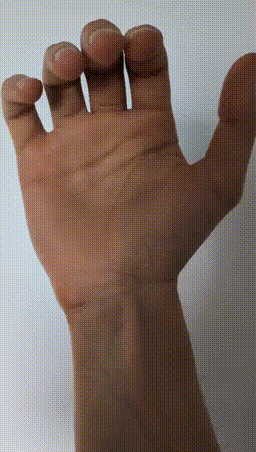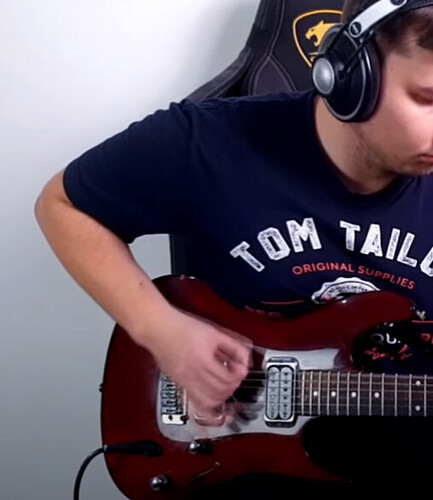Thank you for the response Riffdiculous. That has really helped to put things in context a little.
I wonder if wrist dance is really about tension.
In the air, I can move my wrist either way (with wrist dance and without) and neither feels more tensed than the other. It’s just a different motion.
Although after practicing playing on guitar with pick using only the wrist dance motion for past few months, I seem to be no longer able to play without it. Dunno how to disable it. It became a strong habit.

BTW. why doesn’t the forum allow uploading mp4 files? I can’t upload a high-quality 1MB mp4 video, but I can convert it to a low-quality 2MB gif and upload that ¯_(ツ)_/¯
I think it’s inevitably about tension. The body is a tensegrity structure.
Muscles pull from their origin to their insertion in the direction of the muscle fibres. A contracting muscle acts on all joints it crosses. But, basic physics tells us that if there’s a pull from origin to insertion, there’s an equal and opposite pull from insertion to origin.
The carpi muscles cross the forearm and connect to the upper arm. The muscles don’t “move the wrist,” they contract and pull their points of origin and insertion together.
If the wrist joint moves and there is no motion of the forearm/elbow, there must be some force which holds the forearm and upper arm in place. The only force that can be is muscle tension. At least so far as I inderstand, there’s no other possibility.
In the air without resistance, the muscles don’t need to pull powerfully to create movement at the wrist, so very little holding force is necessary. High frequency movement against resistance requires more powerful activation, so the holding forces would be higher.
Considering all this, if the “optimal” RDT wrist movement is generally diagonal (rather than straight side-to-side deviation), and the muscles have a supporting rotational function, wouldn’t the wrist dance also need to be diagonal?
Has anyone a clip of what is meant with “wrist dance”? Because I have no clue what it’s supposed to be.
There’s a whole thread about it here from a few years ago.
Also, I’ll add that if you keep a keen eye on the form of very “wristy” players, you will see it occasionally (hint: Andy James).
Basically, this:
He is a clear RDT player but he has (at times) a display of this “dance”.
Actually picked up the guitar for the first time in uhh months to try this out; cool exercise! Reminds me of some bass drills I’ve seen for applying 3 finger picking technique to 2 note per string patterns (I think the old John Myung video had tons of that from what I recall, but that was almost 20 years ago lol).
I really enjoy these threads about Anton because people like @Andjoy will highlight cool exercises he does, which have been rewarding to play. I’m not sure if he sells just a PDF of those, but I would be willing to buy it.
This “wrist dance” conversation seems to be a red herring. I’ve said it before, but I don’t believe anyone’s technique is 100% isolated to a single joint or plane of motion; if anything, I now believe everyone has some degree of finger, wrist, forearm, elbow, and even shoulder motion. The “wrist dance” probably refers to synching these motions most effectively for the player.
Interesting, you’ve got one of the best wrist dance’s I’ve ever seen  I was even thinking of DM’ing you and asking you how you even came up with your wrist motion.
I was even thinking of DM’ing you and asking you how you even came up with your wrist motion.
As far as I am aware, it’s mostly meant as a stand-alone exercise to improve relaxation/tension awareness; however, most often it’s presented as straight side-to-side deviation, which I’m curious about.
Thanks! Lol I would be totally down to chat about it, or just go back and forth in threads. I think I’ve posted a good bit about what I think is going on with my technique, but I’m always learning new stuff about it.
From what I’ve read in the thread so far, I haven’t seen anything posted as an exercise to develop / practice the “wrist dance”. Did I overlook something?
Just from my own playing experience (and from what I’ve seen of Anton, and that clip of him talking about Paul Gilbert), there’s no way that his playing is pure wrist deviation. Definitely forearm rotation at points, and likely flexion / extension of the wrist as well.
The whole ‘wrist dance’ thing completely falls apart under close scrutiny imo. In Antons own videos (specifically the single string video when he starts doing the fast trem and the nuclear bleed video)
His forearm/elbow gets involved like 99.9% of all players that go above 200+ bpm. I mean, does anyone have videos of players doing anything resembling the mythical ‘wrist dance’ at high tempos?
Further to that, are there any videos showcasing it who are not built like Anton and PG (i.e lanky with long arms/forearms)
I don’t think he uses his elbow on nuclear bleed. I think at his highest speeds, due to inertia and him being very balanced/controlled in whatever tension is necessary, it will look like his elbow moves. It’s not the same as Rusty Cooley style elbow. Basically his wrist is driving but the elbow comes along for the ride, as opposed to the “stiff arm” classic elbow motion.
Here’s a still image from nuclear bleed. His frame rate is low so we see blurring, but notice how only his hand is blurred. If this were true elbow motion, we’d see that same blur on the whole forearm I think.
Correct, I guess should have clarified that I think it’s a ‘combined movement’ rather than a ‘stiff arm’ approach.
My main point was that I am yet to see really fast motions that are exclusively ‘wrist’ therefore making the ‘wrist dance’ an oversimplification of what’s really going on.
Could someone please explain to me what the fuck the “wrist dance” even is? Is it a slight rotational motion of the forearm as a side effect of using wrist deviation or RDT to pick?
Does the wrist dance function something like the swivel technique for bass drumming?
In that case once the main motion has increased in frequency to the point that there’s no longer enough range available you introduce a perpendicular motion to regain some range.
It probably also reduces fatigue by varying the movement.
(This post may well contain misunderstandings of both guitar AND drum technique)
@Tom_Gilroy gave the best explanation of it above. The “wrist dance” is an incidental movement of the forearm that occurs during wrist motion at slow speeds. “At slow speeds” is an important caveat here because Anton’s wrist dance (and those of other RDT players) disappears when playing fast. In other words, it’s not essential for fast playing and not worth worrying about.
I also agree with @Pepepicks66 that Anton’s wrist movement is RDT and not pure deviation.
I am deviating from the “wrist dance” with this post, but there´s one statement by Anton that really baffles me. (I already posted a link to the following videos above, but I´d really like to know if I am not getting this right.)
At 05:15 Anton says “It is the string that must avoid the pick, and not opposite.”
At 06:45, he says “The string avoids the pick, but the pick is always at the same depth.”
The quesion I have: is that even possible?
In this video here, you can clearly see how the pick moves the string to the side before then passing OVER the string. The string does not move “down”, or in Anton´s words: the string does not “avoid the pick”.
What you can also see is that the pick depth before and after going over each string is actually the same - so the fact that the “string is moving the pick” and “the pick stays at the same height” are not contradictory statements.
Finally, to add to my confusion, his student Dima here demonstrates how it´s done. I don´t see any wiggle room for the tip of the pick to move to the side before passing the string. Is that because the movement of the pick is too fast, or is it actually possible for the pick to stay unimpeded and move the pick “down and under, out of the way”?
That video is interesting but also not how everyone picks. For example, there is a lot of pick exposure and also it is a pick that has some flexibility in it. Those 2 things will make it more challenging for the pick to move through the string (i.e. pick displaces string rather than vice versa). A stable grip with a pick that has decent stiffness and not tons of pick exposure should make what he says in the other video easily possible.
It’s no secret Anton likes a firm pick hold.
My understanding is that Anton is saying, “pretend the hand is on rails and it smashes the string out of the way.” This means that he has a firm grip on the pick and that his fingers won’t collapse or change shape over the impact, etc.
So it’s easy to do what Anton says at 0.3mm deep, but another thing entirely at 4mm.
I suspect he is OK if the pick bends in the collision, but he likely will not permit the hand to leave its pre-planned path.





